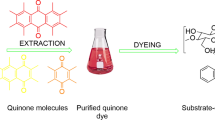Abstract
Three new bleach activators for cotton containing pyridinium (PBBC), nicotinamido (NABBC), and 3-methylpyridinium (3-PBBC) cationic groups were synthesized and characterized by 1H NMR and HPLC–mass spectrometry. They were then applied to cotton fabric in a bleaching process and evaluated for their performance against the prototype N-[4-(triethylammoniomethyl)benzoyl]butyrolactam chloride (TBBC) at a relatively low bleaching temperature (55 °C) and pH 8.5. Measurement of Commission internationale de l’éclairage (International Commission on Illumination) (CIE) whiteness index (WI) values showed that PBBC (WI = 64), NABBC (WI = 58), and 3-PBBC (WI = 71) impart a significant increase in CIE whiteness compared to a control sample (WI = 40). Among the three new activators, 3-PBBC exhibited the best performance. Its WI was comparable to that of fabric bleached using the prototype bleach activator TBBC. The acute toxicity of TBBC and the new bleach activators was evaluated using the microcrustacean Daphnia similis. The chronic toxicity of TBBC and 3-PBBC was evaluated using the green alga Raphidocelis subcapitata, and mutagenicity was evaluated in the Salmonella/microsome assay using the strain TA100. 3-PBBC was 86 times less toxic to D. similis, 18 times less toxic to R. subcapitata, and 10 times less mutagenic to TA100 in comparison with TBBC.






Similar content being viewed by others
References
Cotton Incorporated (2013) Monthly economic letter US and global market fundamentals. Cary: Cotton Incorporated.
Peters RH. Textile chemistry, vol. I: the chemistry of fibres. Amsterdam: Elsevier; 1963.
Peters RH. Textile chemistry, vol. II: purification of fibers. Amsterdam: Elsevier; 1967.
Peters RH. Textile chemistry, volume III: the physical chemistry of dyeing. Amsterdam: Elsevier; 1975.
Lewin M. Handbook of Fiber Chemistry. Boca Raton: CRC/Taylor & Francis; 1967. p. 2007.
Kirner Uwe. Textile-praxis. 1994;22(4):264–71.
Xu CH (2009) The chemistry and perception of fluorescent white materials, NC State University Dissertation.
Xu CH, Hinks D, Shamey R. Bleaching cellulosic fibers via pre-sorption of N-[4-(triethylammoniomethyl)-benzoyl]-butyrolactam chloride. Cellulose. 2010;17(4):849–57.
Hofmann J, Just G, Pritzkow W, Schmidt H. Bleaching activators and the mechanism of bleaching activation. J Prakt Chem. 1992;334:293–8.
Cai JY, Evans DJ, Smith SM. Bleaching of natural fibers with TAED and NOBS activated peroxide systems. AATCC Rev. 2001;1:31–4.
Shao J. Cold pad–batch bleaching of cotton fabrics with a TAED/H2O2 activating system. Color Technol. 2010;126(2):103–8.
Willey AD, Miracle GS, Kott KL, Burns MR, Baillely GMA, Guedira N, Hardy FE, Taylor LF, Sivik MR (1997) Quaternary substituted bleach activators. US Patent 5686015, Procter and Gamble Company.
Lee JJ, Hinks D, Lim SH, Hauser P. Hydrolytic stability of a series of lactam-based cationic bleach activators and their impact on cellulose peroxide bleaching. Cellulose. 2010;17(3):671–8.
Lim SH, Gürsoy NÇ, Hauser P, Hinks D. Performance of a new cationic bleach activator on a hydrogen peroxide bleaching system. Color Technol. 2004;120:114–8.
Lim SH, Lee JJ, Hinks D, Hauser P. Bleaching of cotton with activated peroxide systems. Color Technol. 2005;121(2):89–95.
Xu CH, Shamey R, Hinks D. Activated peroxide bleaching of regenerated bamboo fiber using a butyrolactam-based cationic bleach activator. Cellulose. 2010;17(2):339–47.
Xu CH, Shamey R, Hinks D, El-Shafei A. Cotton bleaching optimization using a butyrolactam-based cationic bleach activator. AATCC Rev. 2012;12(1):66–70.
AATCC (2009) Test method 110-2005: whiteness of textiles. American Association of Textile Chemists and Colorists technical manual, vol 84. Research Triangle Park: American Association of Textile Chemists and Colorists.
AATCC. Evaluation procedure 9-1999: visual assessment of color difference of textiles, American Association of Textile Chemists and Colorists’ technical manual. Research Triangle Park: American Association of Textile Chemists and Colorists; 2011.
OECD (2004) Test no. 202: Daphnia sp. Acute immobilisation test. OECD Guidelines for the testing of chemicals, Section 2. doi:10.1787/20745761.
Hamilton MA, Russo RC, Thurfton RB. Trimmed Spearman-Karber method for estimating median lethal concentration in toxicity bioassays. Environ Sci Technol. 1977;11(7):714–9.
OECD (2011) Test no. 201: freshwater alga and cyanobacteria, growth inhibition test. OECD guidelines for the testing of chemicals, Section 2. Paris: OECD.
US Environmental Protection Agency (1993) A linear interpolation method for sublethal toxicity: the inhibition concentration (ICp) approach (version 2.0).
Kado NY, Langley D, Eisenstadt E. A simple modification of the Salmonella liquid-incubation assay. Increased sensitivity for detecting mutagens in human urine. Mutat Res. 1983;121:25–32.
Bernstein L, Kaldor J, McCann J, Pike MC. An empirical approach to the statistical analysis of mutagenesis data from Salmonella test. Mutat Res. 1982;97:267–81.
Caffaro-Filho RA, Wagner R, Umbuzeiro GA, Grossman MJ, Durrant LR. Identification of alpha-beta unsaturated aldehydes as sources of toxicity to activated sludge biomass in polyester manufacturing wastewater. Water Sci Technol. 2010;61(9):2317–24.
Acknowledgements
The authors gratefully acknowledge Cotton Incorporated for financial support.
Author information
Authors and Affiliations
Corresponding author
About this article
Cite this article
Wang, G., Umbuzeiro, G.d., Vendemiatti, J.A. et al. Synthesis, Characterization, and Toxicological Properties of New Cationic Bleach Activators. J Surfact Deterg 20, 277–285 (2017). https://doi.org/10.1007/s11743-016-1899-3
Received:
Accepted:
Published:
Issue Date:
DOI: https://doi.org/10.1007/s11743-016-1899-3




